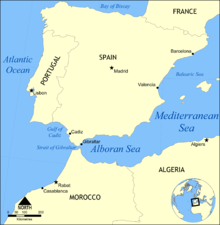- Alboran Sea
-
Coordinates: 36°0′N 3°0′W / 36°N 3°W
The Alboran Sea is the westernmost portion of the Mediterranean Sea, lying between Spain on the north and Morocco and Algeria on the south. The Strait of Gibraltar, which lies at the west end of the Alboran Sea, connects the Mediterranean with the Atlantic Ocean.
Its average depth is 1,461 feet (445 m) and maximum depth is 4,920 feet (1,500 m).
The International Hydrographic Organization defines the limits of the Alboran Sea as follows:[1]
On the West. The Eastern limit of the Strait of Gibraltar [A line joining Europa Point to P. Almina (35°54′N 5°18′W / 35.9°N 5.3°W)].
On the East. A line joining Cape de Gata (Spain) to C. Fegalo (Africa) (35°36′N 1°12′W / 35.6°N 1.2°W).
Surface currents in the Alboran Sea flow eastward, bringing water from the Atlantic into Mediterranean; deeper subsurface currents flow westward, carrying saltier Mediterranean water into the Atlantic. There is typically a rotary circulation, also known as a gyre, in the Alboran Sea as a result of this exchange of water.[2] The Alboran Sea is a transition zone between the two seas, containing a mix of Mediterranean and Atlantic species. The Alboran Sea is habitat for the largest population of bottlenose dolphins in the western Mediterranean, is home to the last population of harbour porpoises in the Mediterranean, and is the most important feeding grounds for loggerhead sea turtles in Europe. The Alboran sea also hosts important commercial fisheries, including sardines and swordfish. In 2003, the World Wildlife Fund raised concerns about the widespread drift net fishing endangering populations of dolphins, turtles, and other marine animals.
Several small islands dot the sea, including the Isla de Alborán. Most, even including those closer to the Moroccan shore are controlled by Spain.
An arc of mountains, known as the Gibraltar Arc, wraps around the northern, western, and southern sides of the Alboran Sea. The Gibraltar Arc is made up of the Baetic Cordillera of southern Spain and the Rif Mountains of Morocco. These mountains, known to ecologists as the Baetic-Rifan complex, are one of the Mediterranean's biodiversity hotspots; like the Alboran sea, the Baetic-Rifan complex is a transition between the Mediterranean and Atlantic (Macaronesian) ecologies. The moderating influence of the Atlantic has allowed many species in the Baetic and Rif mountains to survive the climatic fluctuations of the last few million years that caused them to become extinct elsewhere around the Mediterranean basin.
References
- ^ "Limits of Oceans and Seas, 3rd edition". International Hydrographic Organization. 1953. http://www.iho-ohi.net/iho_pubs/standard/S-23/S23_1953.pdf. Retrieved 7 February 2010.
- ^ C.Michael Hogan. 2011. Alboran Sea. eds. P.Saundry & C.J.Cleveland. Encyclopedia of Earth. National Council for Science and the Environment. Washington DC
Categories:- Marginal seas of the Mediterranean
- Landforms of Spain
- Landforms of Morocco
- Landforms of Algeria
- Morocco–Spain border
- Gibraltar–Spain border
- Algeria–Morocco border
Wikimedia Foundation. 2010.


